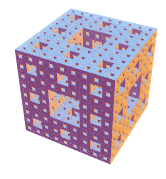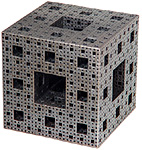 Waclaw Sierpinski was a Polish mathematician who lived from 1882 til 1969. In 1915 he described what became known as the "Sierpinski gasket", which is a kind of fractal (which has, incidentally, been documented as appearing in Italian art from about the 13th century). The gasket is also called the Sierpinski "sieve" or Sierpinski "triangle". (source: mathworld.wolfram.com). It's created by the following "beautiful recurrence equation":
Waclaw Sierpinski was a Polish mathematician who lived from 1882 til 1969. In 1915 he described what became known as the "Sierpinski gasket", which is a kind of fractal (which has, incidentally, been documented as appearing in Italian art from about the 13th century). The gasket is also called the Sierpinski "sieve" or Sierpinski "triangle". (source: mathworld.wolfram.com). It's created by the following "beautiful recurrence equation":As you can doubtless see, the geometric method of creating the gasket is to start with a triangle and cut out the middle piece. This results in three smaller triangles to which the process is continued. The nine resulting smaller triangles are cut in the same way, and so on, indefinitely. (source: astronomy.swin.edu.au)
 Now consider the Sierpinski carpet. Same deal as the gasket, but constructed with squares, instead of triangles. It can be described "using string rewriting beginning with a cell [1] and iterating the rules":
Now consider the Sierpinski carpet. Same deal as the gasket, but constructed with squares, instead of triangles. It can be described "using string rewriting beginning with a cell [1] and iterating the rules":This is all fine and dandy, but "so what" I hear you say. So lets look at the "carpet" in three dimensions (below, left). We're suddenly presented with an object of uncommon beauty, which is typified by the interesting characteristics of inversely proportionate volume and surface area.
 (That is, the more iterations of the 'pattern' are made, the surface area increases in direct proportion to the volume, which decreases). (Aside: Fractal antennae based upon the Sierpinski carpet can be used in communication devices such as cell-phones, where they can give far superior performance over the usual rubbery stalk.)
(That is, the more iterations of the 'pattern' are made, the surface area increases in direct proportion to the volume, which decreases). (Aside: Fractal antennae based upon the Sierpinski carpet can be used in communication devices such as cell-phones, where they can give far superior performance over the usual rubbery stalk.) This "cube" is also called a Menger sponge. The Menger sponge, in addition to being a fractal, is also a super-object for all compact one-dimensional objects, i.e., the topological equivalent of all one-dimensional objects can be found in a Menger sponge (Peitgen et al. 1992). (Hmmmmmmmm.) (Make sure you play with the cool 3d models, too).
This "cube" is also called a Menger sponge. The Menger sponge, in addition to being a fractal, is also a super-object for all compact one-dimensional objects, i.e., the topological equivalent of all one-dimensional objects can be found in a Menger sponge (Peitgen et al. 1992). (Hmmmmmmmm.) (Make sure you play with the cool 3d models, too).So back to yesterday's DomPost story, which describes how the New York Folk Art museum (described, no doubt for calculated effect, as a major
 New York art museum) has "picked up" (actually, had donated) two works by local Wellinton "outsider" artist Martin Thompson (pictured, right). This was some sort of post-script to an exhibition of 40 "obsessive" drawings by five international artists, including Thompson, which closed at the museum last month.
New York art museum) has "picked up" (actually, had donated) two works by local Wellinton "outsider" artist Martin Thompson (pictured, right). This was some sort of post-script to an exhibition of 40 "obsessive" drawings by five international artists, including Thompson, which closed at the museum last month.The works illustrating the article (left) are not actually the works in question, but any mathmetician worth his salt would immediately identify Thompson's "obsessive" "geometric abstraction" as an execution of a variation on Sierpinski's carpet.
Which basically leaves me wondering, well, when does advanced mathematics become art, folk or not? (And also cursing my laziness at not picking up some of his work, when I met him about five years ago, for a lot less than the $3000 or so they are each commanding now.) But mostly thinking "why don't I understand this?" I personally don't care if Thompson has been copying illustrations from a tome on fractals from the 70s for twenty-six years (very popular, they were in the 70s, fractals); or rendering his own formulae (and those of others); or if it's a complete coincedence; or all of the above. But what is the American Folk Art Museum playing at, for example? And what is discovering their $3000 "outsider art" drawing is actually copied out of a 200-level university maths text book going to mean to all the people who have reportedly been lining up to buy a piece of the action?
Some web-resources on Martin Thomson, most showing more examples of his work:
> Obsessive Drawing, at the American Folk Art Museum, 2006.
> Review of Dirty Pixels, which premiered at Artspace in August 2002 accompanied by a catologue. The show was also exhibited by Adam Art Gallery from April 12-25 2003 and finished showing at the Waikato Museum of Art on 18 January 2004
> Biography of Martin Thompson on Stuart Shepherd's Self-Taught & Visionary Art in New Zealand resource.

PS: As an artist Taylor is not alone in his mathematics fixation. This image (right) shows a metal rendition of the Menger sponge created by digital sculptor Bathsheba Grossman.
SEE ALSO: Box Fractal, Cantor Dust, Cantor Square Fractal, Delannoy Number, Haferman Carpet. Hours of fun.


2 comments:
Ah, the proud, the geeky.
I would never wish to answer what the point of art was, but I will say that Thompson's art is only fractal-esque and not actually fractals at all. Note the many differences between the art pictured in the DomPost and the Sierpinski Gasket.
Instead what he has done is closer to Escher: a tessellation. In truth it's an irregular tessellation. Fractal just sounds cooler
Thompson probably has some rules that he follows and from them he produces art. But i doubt that they are chaotic.
Hmmm, this looks like another blog-post for the Mathletes.
On a personal basis I like his work. I used to do similar stuff when I was (much) younger, just not as well.
Hadyn: if anything Thompson's work is more complex than the basic iterated function systems fractals such as the Sierpinski carpet. It might be possible to create it from a single string rewriting rule (as Stephen shows for the Sierpinski once), but at a first guess I'd imagine that you'd need two rules: one for the main carpet and one for the "holes".
They're definitely more fractals than they are tessellations, though. I'm not sure what you mean by "irregular" tessellations, unless you mean something like a Penrose tiling. But Marty's work is nothing like that: it displays obvious recursive self-similarity and scale invariance.
Of course, you're right in the strict sense, because no drawing in the real world can ever be a true fractal. It can only be an approximate fractal, because you can't repeat the iteration infinitely and the medium has resolution limitations. In Marty's case, that limited resolution is made explicit by the use of the grid. But he definitely uses algorithms that if continued to infinity would produce a figure with a Hausdorff-Besicovitch dimension greater than its topological dimension, which as any fule no, is the definition of a fractal.
From our discussion on Friday night (which was relatively sober since we were only up to our second Kirin) and your comment ("But i doubt that they are chaotic"), I think you are limiting yourself to a subset of fractals. Chaotic systems have attractors in phase space that are fractal, but it's not the other way around: not every fractal has to be the phase-space representation of a chaotic system. In fact, many of the classic examples of fractals (Koch Snowflake, Peano Curve) are deterministic fractals with exact self-similarity.
In any case, I think that there is almost certainly a simple recursive algorithm behind Marty's work: probably a string-rewriting iteration like the Sierpinski carpet, but with a shift of the frame between interations. Does that disqualify it as art? Hell no! Does it allow it to be "good" or interesting art? I think it is, but that's another question entirely.
Post a Comment